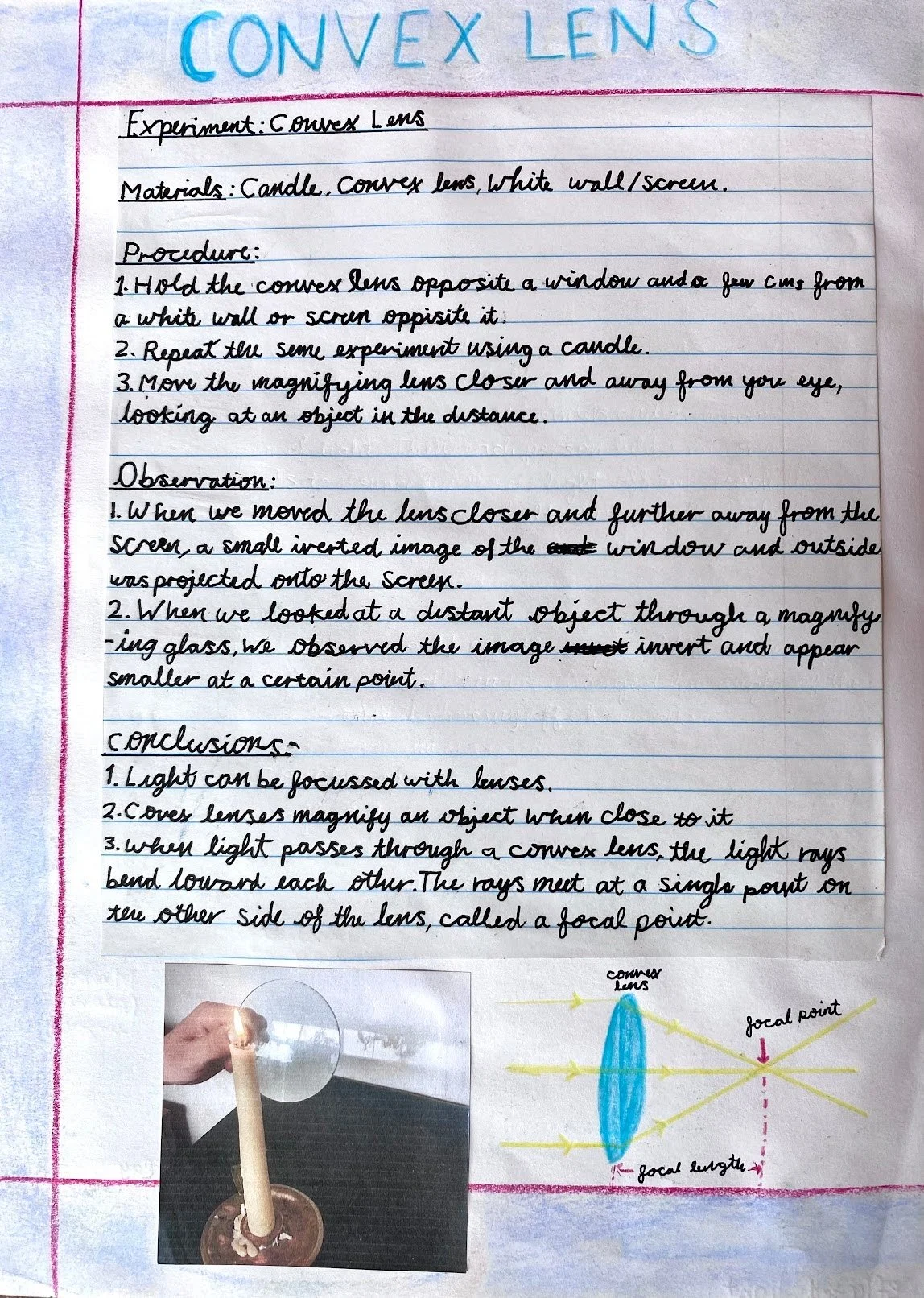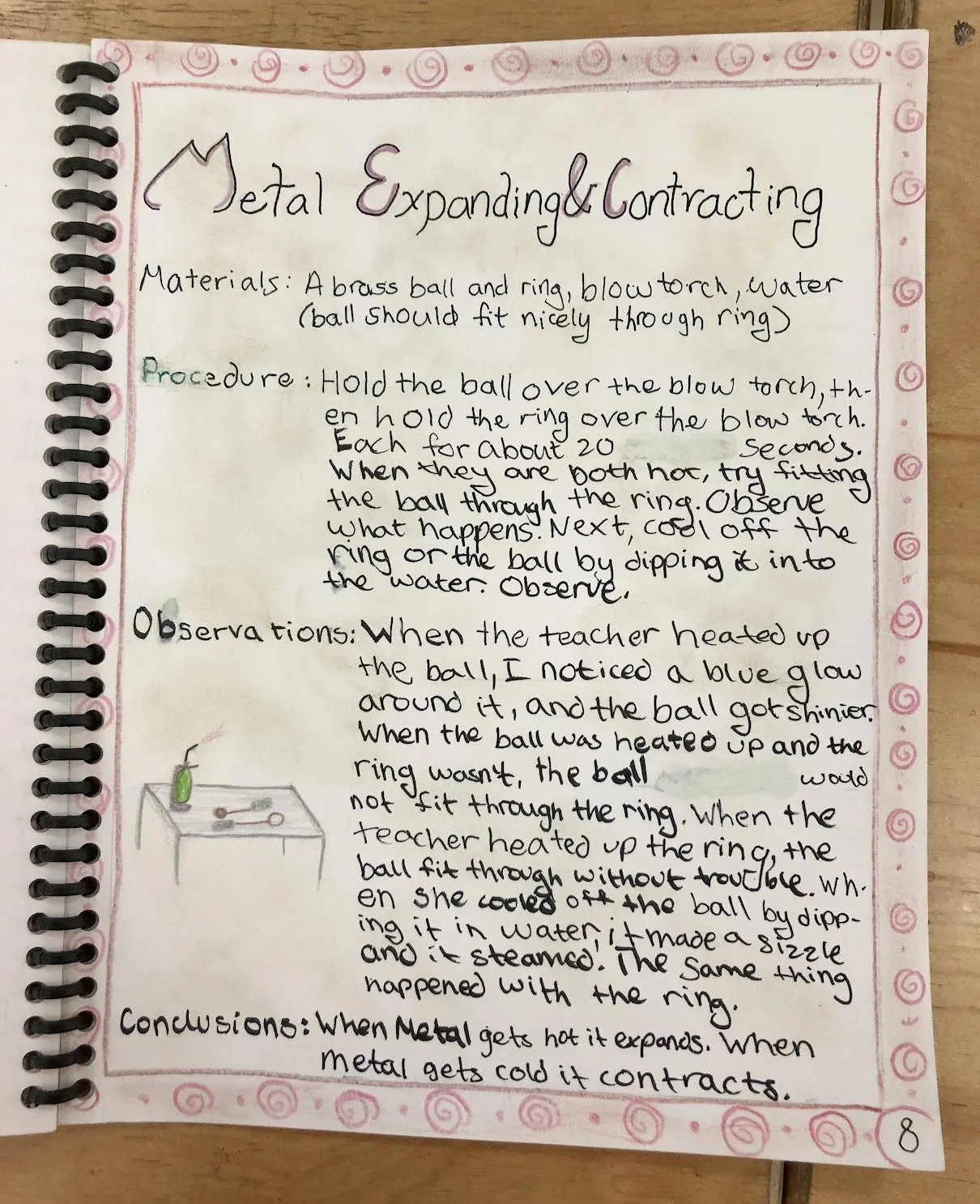Waldorf Science Curriculum: What is the role of formal lab write-ups in middle school?
A: When a student enters sixth grade, the curriculum shifts to meet them just where they are in their development in many ways…
An example of a student lab write-up from our seventh grade Chemistry class.
…one of them being the study of science- physics, geology, astronomy, and more as the grades progress!
In 6th grade Physics specifically (and in Chemistry blocks later in 7th and 8th grade), the educator will introduce the practice of creating formal lab write-ups, which illustrate the materials, methods, observations, and conclusions of a single science experiment. After an experiment has been fully demonstrated and discussed, the lab write-up is the final step in reviewing what has been learned and discovered.
(Our science courses for Physics (grades 6-8) and Chemistry (grades 7-8) include templates and helpful guides to get started with science write-ups in your homeschooling curriculum!)
These formal lab write-ups are where science and language arts work closely together!
Though on its surface this sounds simple and straightforward, science lab write-ups pose a whole new challenge for the budding scientist, and are a tool used by the educator to build observational and objective communication skills. These science write-ups provide an opportunity to practice writing what we see, hear, smell, feel and taste, all through using clear, accurate and objectively written descriptions.
Removing opinions, and describing the facts!
With this practice, the educator poses such questions as:
“What do we need to complete this experiment?”
“What is the method used, or, how does one actually do this experiment from start to finish?”
“What happens during this experiment? What did you see throughout the experiment?”
“What conclusions can be reached from your observations?”
Writing all of this objectively is actually much harder than it seems!
When I first introduced science write ups to my 6th grade class, I challenged my class to write a simple guide for me: “How to Make a Peanut Butter and Jelly Sandwich”- from start to finish.
Students learn the principles of thermodynamics through our 6th grade physics curriculum- learning by doing! Find the science write-up for this experiment in the next image.
What would I need to make a PB & J? How should I do it? What challenges should I be aware of, or what techniques worked best? What should I expect to end up with after applying the method?
Then, after writing their PB & J write-ups, it was my job to make these sandwiches in front of the class, but I could only do what the science write-up said- literally! No guesses, inferences, or assumptions on my part- I had to follow the instructions exactly as written.
As you can imagine, this was a very entertaining lesson- and an effective one! Students unknowingly left out all kinds of ingredients, tools, and steps (resulting in very silly sandwiches!)
All demonstrating that when we write a lab write-up, we have to be specific, methodical, and objective.
Writing our observations proved to be a challenge as well, which we discussed with the PB & J demonstration. To practice communicating observations, I asked the students to describe a PB & J sandwich. What does it look, smell, taste, or feel like?
Many students wrote that a sandwich tastes “Good!” or “The bread was especially tasty.” Almost all wrote their opinions about the sandwich. If we imagine the reader had never seen a PB & J sandwich, words like “good” or “tasty” actually do not describe anything other than one’s preferences and opinions; they don’t provide a detailed depiction of the sandwich itself!
After working through an experiment and discussing the results, it’s time to bring it all together in a science write-up. This is an example of student work after observing how metal expands and contracts; the laws of thermodynamics in action!
Instead, we discussed using objective and clear descriptive word choices and sentences.
“The bread is soft and white, while the jelly is somewhat sticky and tastes sweet.”
“The peanut butter is smooth to spread and has a very nutty taste.”
Already, with these simple adjustments in our language, a reader will be able to get a much better idea of what the student actually observed with their senses.
This exercise translated well over to our science experiments and subsequent formal lab write-ups. For example, when the students studied acoustics, we found all kinds of descriptive words to use for observations: “hollow,” “tinny,” “ringing,” “grating,” “soft,” “muffled,”- the list goes on.
Here is where science and language arts become one!
Formal lab write-ups provide a way to meld together science and language. The process pushes students to remove their opinions, and focus on what their senses experience in an objective way- perfect for the sixth grader who is beginning their journey into the often unsettled and murky experience of puberty! While the experiments in a science block are of course important, the formal lab write-up provides a structure for the student to process their observations, grow in their writing skills, and find the truth outside opinion.
Looking to add Waldorf-inspired science to your homeschool classroom?
About the Authors
Robyn Beaufoy is Waldorfish’s CEO, and also a course instructor for Simple Season (coming soon!), Waldorf Art for Beginners, and Weekly Art Foundations. You’ll find her intuitive touches and influences throughout everything Waldorfish offers. Robyn has been in the world of education for over 25 years, with an MA in Education and a certification in Waldorf teaching - she also homeschooled both of her children for some of that time. In 2012 Robyn co-founded Waldorfish.com, creating it with the vision of making Waldorf inspired-art and pedagogy more accessible, joyful, and doable for homeschoolers all over the world.
Caitlin Amajor is Waldorfish’s course instructor for Geometry grades 5 & 6, and Botany, as well as our Administrative Assistant. From a young age, Caitlin has been immersed in Waldorf education, attending a Waldorf school from K-8. After receiving a BA in History, Caitlin gained her certification in Waldorf teaching, and spent seven years as a Waldorf class teacher in the upper grades. With a special fondness for watercolor painting and geometry, Caitlin loves bringing Waldorf education to her students all over the world, and seeing their own individuality and style bloom from the curriculum!



